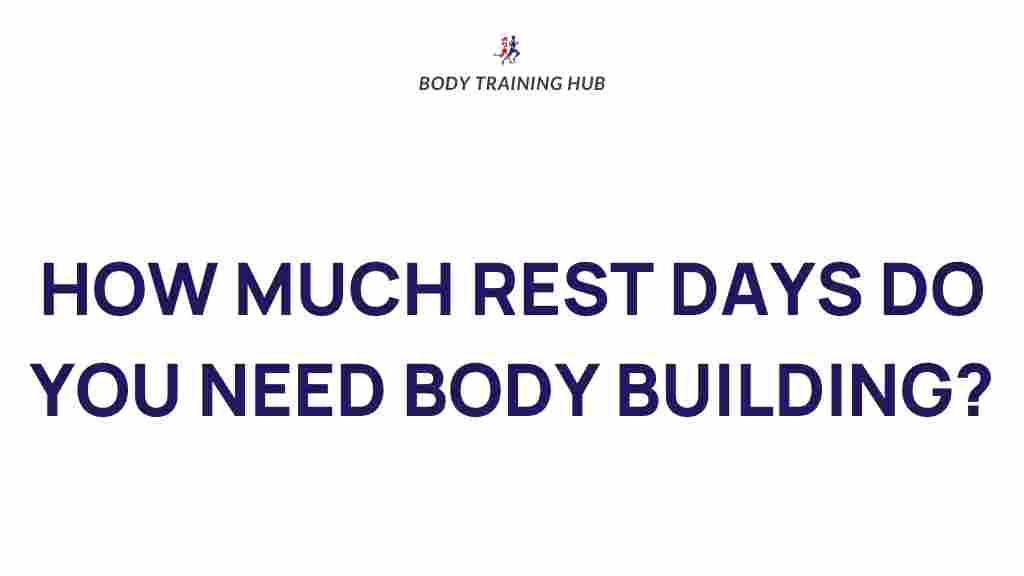Unveiling the Secret to Optimal Rest Days in Bodybuilding
When it comes to bodybuilding, many enthusiasts focus intensely on their workout schedules, striving to push their limits at every session. However, a critical component often overlooked in the pursuit of muscle growth is the significance of rest days. Understanding the importance of recovery can be the difference between stagnation and progress. In this article, we will explore the essential role of rest days in bodybuilding, how to incorporate them into your training routine, and tips for maximizing recovery.
The Importance of Rest Days in Bodybuilding
Rest days are integral to any effective bodybuilding program. They allow your muscles to recover, repair, and ultimately grow stronger. Here are some key reasons why rest days are vital:
- Muscle Recovery: Weightlifting causes micro-tears in muscle fibers. Rest days allow these tears to heal, leading to muscle growth.
- Prevention of Overtraining: Continuous training without adequate rest can lead to overtraining syndrome, which can hinder performance and increase the risk of injury.
- Hormonal Balance: Adequate rest helps regulate hormones like cortisol and testosterone, essential for muscle growth and recovery.
- Mental Health: Taking a break can help refresh your motivation and focus for future workouts.
How to Structure Your Workout Schedule with Rest Days
Creating a balanced workout schedule that includes rest days requires planning and understanding your individual needs. Here’s a step-by-step process to help you structure your training effectively:
Step 1: Assess Your Current Level
Before designing your workout schedule, evaluate your current fitness level. Beginners may need more frequent rest days compared to advanced lifters. Consider the following:
- How many days per week do you currently train?
- What is your lifting experience?
- How do you feel after workouts? Are you overly fatigued?
Step 2: Determine Your Training Goals
Your goals will influence how often you should include rest days. If your primary focus is muscle growth, you might want to include:
- 1-2 rest days per week for hypertrophy-focused training.
- Active recovery days incorporating light cardio or mobility work.
Step 3: Create a Balanced Schedule
Here’s a sample workout schedule that incorporates rest days effectively:
- Monday: Upper Body Strength
- Tuesday: Lower Body Strength
- Wednesday: Rest Day
- Thursday: Push Day
- Friday: Pull Day
- Saturday: Legs Day
- Sunday: Rest or Active Recovery
This schedule provides a balance of workout intensity and recovery time, promoting optimal muscle growth.
Maximizing Recovery on Rest Days
Simply taking a break from the gym doesn’t guarantee recovery. Here are some tips to help you maximize your rest days:
1. Nutrition is Key
Focus on nutrient-dense foods that promote recovery:
- Protein: Essential for muscle repair. Include sources like chicken, fish, beans, and legumes.
- Carbohydrates: Replenish glycogen stores with whole grains, fruits, and vegetables.
- Healthy Fats: Support hormone production with nuts, seeds, and avocados.
2. Hydration
Staying hydrated is crucial for recovery. Aim to drink plenty of water throughout your rest days to aid in muscle repair and overall health.
3. Sleep
Quality sleep is one of the most effective recovery tools. Aim for 7-9 hours of sleep per night to optimize muscle recovery and hormone balance.
4. Active Recovery Techniques
Incorporating low-intensity activities can promote blood flow and recovery:
- Light cardio (walking, cycling)
- Yoga or stretching
- Foam rolling or massage
Troubleshooting Common Recovery Issues
Even with a well-structured workout schedule, you may encounter issues with recovery. Here’s how to troubleshoot:
Feeling Fatigued Despite Rest
If you’re still feeling tired even after taking rest days, consider:
- Evaluating your nutrition: Ensure you’re consuming enough calories and nutrients.
- Assessing your sleep quality: Are you getting restful sleep or experiencing disturbances?
- Reducing workout intensity: You may need to lower the weight or volume of your workouts temporarily.
Injury Concerns
If you’re dealing with persistent pain or injury, it’s crucial to:
- Consult a fitness professional or a doctor.
- Incorporate more rest days as needed.
- Adjust your workout technique or routines to avoid further injury.
Listening to Your Body
Perhaps the most important aspect of managing rest days is learning to listen to your body. If you’re feeling unusually fatigued, anxious, or sore, it’s essential to adjust your workout schedule accordingly. Remember, recovery is not a sign of weakness; it’s a fundamental part of the bodybuilding process.
Conclusion
Incorporating adequate rest days into your bodybuilding routine is essential for muscle growth and overall health. By understanding how to structure your workout schedule effectively and maximizing recovery techniques, you can enhance your performance and prevent burnout. Remember that muscle growth occurs not just in the gym, but during rest and recovery. So, prioritize your rest days, and watch your progress soar!
For more insights on optimizing your bodybuilding journey, check out this comprehensive guide. And for additional tips on nutrition and recovery, visit this resource.
This article is in the category Strength & Recovery and created by BodyTraining Team
